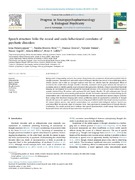Use este identificador para citar ou linkar para este item:
https://repositorio.ufrn.br/handle/123456789/25588| Título: | Speech structure links the neural and socio-behavioural correlatesof psychotic disorders |
| Autor(es): | Palaniyappan, Lena Mota, Natália Bezerra Oowise, Shamuz Balain, Vijender Copelli, Mauro Ribeiro, Sidarta Tollendal Gomes Liddle, Peter |
| Palavras-chave: | disorganisation;bipolar disorder;schizophrenia;thought disorder;gyrification;centrality;graph theory |
| Data do documento: | 8-Jul-2018 |
| Referência: | PALANIYAPPAN, Lena; MOTA, Natália Bezerra; OOWISE, Shamuz; BALAIN, Vijender; COPELLI, Mauro; RIBEIRO, Sidarta; LIDDLE, Peter Liddle. Speech structure links theneural and socio-behavioural correlates of psychotic disorders. Pnp, jul., 2018. Disponível em: <https://www.sciencedirect.com/science/article/pii/S0278584618302975?via%3Dihub>. Acesso em: 12 jul. 2018. |
| Resumo: | Background: A longstanding notion in the concept of psychosis is the prominence of loosened associative links in thought processes. Assessment of such subtle aspects of thought disorders has proved to be a challenging task in clinical practice and to date no surrogate markers exist that can reliably track the physiological effects of treatments that could reduce thought disorders. Recently, automated speech graph analysis has emerged as a promising means to reliably quantify structural speech disorganization. Methods: Using structural and functional imaging, we investigated the neural basis and the functional relevance of the structural connectedness of speech samples obtained from 56 patients with psychosis (22 with bipolar disorder, 34 with schizophrenia). Speech structure was assessed by non-semantic graph analysis. Results: We found a canonical correlation linking speech connectedness and i) functional as well as developmentally relevant structural brain markers (degree centrality from resting state functional imaging and cortical gyrification index) ii) psychometric evaluation of thought disorder iii) aspects of cognitive performance (processing speed deficits) and iv) functional outcome in patients. Of various clinical metrics, only speech connectedness was correlated with biological markers. Speech connectedness filled the dynamic range of responses better than psychometric measurements of thought disorder. Conclusions: The results provide novel evidence that speech dysconnectivity could emerge from neurodevelopmental deficits and associated dysconnectivity in psychosis. |
| URI: | https://repositorio.ufrn.br/jspui/handle/123456789/25588 |
| Aparece nas coleções: | ICe - Artigos publicados em periódicos |
Arquivos associados a este item:
| Arquivo | Descrição | Tamanho | Formato | |
|---|---|---|---|---|
| SidartaRibeiro_Speechstruturelinks_2018.pdf | 1,04 MB | Adobe PDF |  Visualizar/Abrir |
Os itens no repositório estão protegidos por copyright, com todos os direitos reservados, salvo quando é indicado o contrário.

